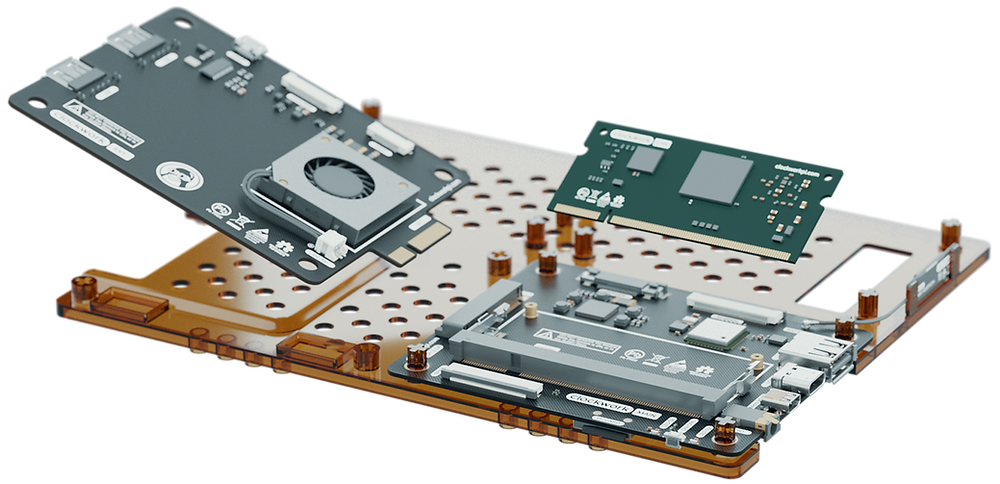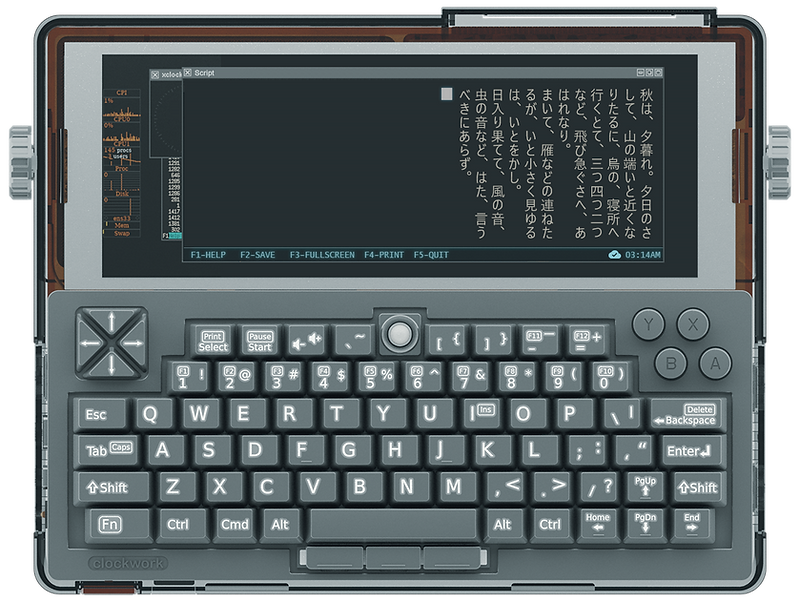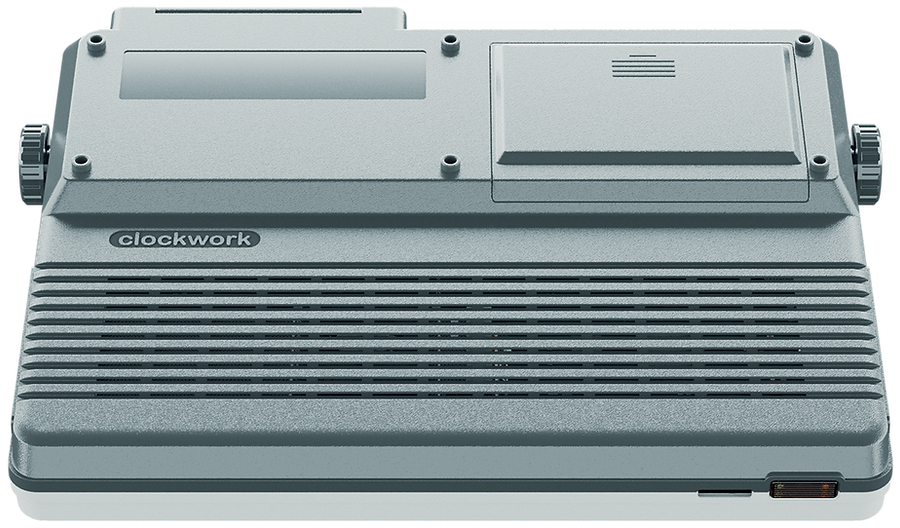c
Mainboard
6
Introducing the ultra-compact clockworkPi v3.14
ClockworkPi v3.14 integrates up to 12 interfaces in the ultra-small size of 95x77mm, ensuring sufficient connectivity for your work and entertainment. Following an easy-to-upgrade modular design of CPU and memory, clockworkPi v3.14 allows you to freely choose a suitable "Core" for various application scenarios.
clockworkPi v3.14 is compatible with the Raspberry Pi CM3 series, which means that your work on the Raspberry Pi can be "teleported" to a portable terminal in seconds!

Tech Specs
-
CPI v3.14 uses a compact design, the size is reduced to 95x77mm.
-
PMU chip which supports reliable and complete lithium battery charge and discharge management
-
Integrated 5G-WIFI (802.11ac) + Bluetooth 5.0
-
High-gain antenna
-
Standard USB-A 2.0 interface x 3 and, an internal contact interface for the Keyboard module
-
USB-C* charging port
-
TF card (Micro SD card) slot**
-
40 Pins MIPI screen interface
-
Micro-HDMI interface
-
3.5 headphone jack, supports microphone input
-
Onboard stereo audio power amplifier chip
-
40 Pins GPIOs expansion interface (using standard 0.5mm FPC connector)
-
52 Pins extension module interface (using standard Mini PCI-E connector) for the “EXT. module”
-
Standard DDR2-SODIMM 200 Pins interface: connects CPI v3.14 to the "Core module"
The schematics and related design materials are released under the GPL v3 license, and you can find them on our GitHub.
* Depends on the "Core Module" features.
** The tested maximum capacity is 256GB.
c
Core module
5
Introducing the upgrade-friendly Cores
This time we will first introduce four core modules plus Raspberry Pi CM3; you will have 5 configurations to choose from:
Model
A-0401
A-0402
A-0602
A-0604
RPI-CM3
CPU Microarchitecture
ARM64-bit Quad-core Cortex-A53
ARM64-bit Quad-core Cortex-A53
ARM64-bit Dual-core Cortex-A72
ARM64-bit Quad-core Cortex-A53
ARM64-bit Dual-core Cortex-A72
ARM64-bit Quad-core Cortex-A53
ARM64-bit Quad-Core Cortex-A53
(Raspberry PI CM3+ LITE)
Freq.
1.8GHz
1.8GHZ
1.8GHz
1.4GHz
1.8GHz
1.4GHz
1.2GHz
Cores
4
4
6
6
4
GPU
Mali-T720
Mali-T720
Mali-T864
Mali-T864
VideoCore 4
RAM
1GB DDR3
2GB DDR3
2GB LPDDR4
4GB LPDDR4
1GB LPDDR2
The A-04 series and RPI-CM3 are suitable for general purposes with longer usage time, such as writing, coding, e-mails, making indie-games, running most video game emulators, etc. If you usually use “Web Applications,” the A-0402 core module provides you with more memory to improve the experience.

For users who require high performance and computing power, such as for AI/algorithm development and tuning, rapid prototyping of embedded devices, speeding up your compile-time, etc., the A-06 series will provide you a better solution. We also provide you with an option of the "DevTerm Kit" without the "Core Module."
The schematic and related design materials are released under the GPL v3 license, and you can find them on our GitHub.
Notice: We are also evaluating and testing more CPU architectures, such as FPGA+ARM, RISC-V, and even X86 architecture, and look forward to bringing you more exciting Cores shortly.
c
Ext. module
7
Introducing the DIY-friendly Ext. module
We specially cut the mainboard in half. Half of it is reserved and used to carry the imagination and possibility of DIY, and this half is called the "Ext. Module."
Tech Specs:
-
94x77mm size
-
Mini booster fan (6000RPM, the airflow towards CPU)
-
Thermal printer interface
-
Standard MIPI-CSI (camera interface)
-
Two standard USB-A interfaces
-
Dual speaker (left and right channel) interface
-
Micro USB-UART debugging interface
-
52Pin golden fingers to connect to the mainboard

The schematic and related design materials are released based on the GPL v3 license, and you can find them on our GitHub.
More possibilities, such as AI accelerator, 4G/5G module, Software-defined Radio, oscilloscope, FPV ground station, audio mixer, game cassette reader, EEG/ECG monitoring modules, and even microscopic slide analyzer modules have already been envisioned. As some areas of the application potential have far exceeded our background, we especially look forward to seeing you in our community, experts from various professional fields, bringing in extremely exciting and creative works to DevTerm.

c
Screen
8
Ultrawide 6.8-inch IPS screen
This ultrawide 6.8-inch IPS screen with a full viewing angle has been carefully selected for you. Its aspect ratio has reached an astonishing 16:6 (a typical retro-style proportion). The resolution is 1280x480, which is precisely equal to dual VGA. We hope this screen can bring you a vintage-feeling, focused, and immersive experience.

c
Keyboard
;
Introducing the clockwork 65% keyboard
We are very excited to bring you a classical layout keyboard with 67 keys. A physical mini trackball with OK function and three mouse buttons, the trackball uses four high-sensitivity and high-reliability designs based on Hall-effect sensors. A set of retro-style gamepad arrow keys and four buttons included; these eight keys all use independent IO design to ensure minimal delay in response.

The keyboard central control unit adopts the Arm® Cortex-M3 architecture, which is fully compatible with the Arduino STM32 development environment. A Micro USB-UART programming port allows you to reprogram and customize the keyboard firmware easily.
The USB POGO Pin on the back of the keyboard is naturally connected to the mainboard, saving you the tedious operation of cable connection.

The firmware source code, schematic, and related design materials are released under the GPL v3 license, and you can find them on our GitHub.
We hope this keyboard can help to capture your inspiration anytime, anywhere, whether you are keeping a diary, writing a novel, or making an indie game.


State of removing the front shell.
c
Battery module
9
We carefully designed the battery holder to make it more compatible with various 18650 battery sizes: Φ18±0.5mm diameter, 65-69mm length. The battery module has "Short Circuit and Reverse Polarity Protection" features, but you are still advised to purchase* the batteries from a reliable distributor and install them correctly.

Theoretically, you could use a single 18650 battery to power the system or replace the batteries one by one even when the system is in use. These actions can still cause system instability, and we strongly recommend replacing the batteries after the system is powered down. Please remove the battery if you do not use the device for a long time. Please consult the battery supplier for detailed 18650 safe usage rules, and please strictly follow them.
* Please note: the 18650 batteries are NOT included in the package due to global logistics complexity for lithium batteries.
c
Thermal Printer Components
D
We provide you a vintage-feeling but practical expansion module - the thermal printer. It uses a standard 58mm thermal paper and has an easy-to-load design. With the open-source standard CUPS print driver provided by the clockworkOS, you can print various monochrome fonts, symbols, graphics, and even complete A4 size output through collage. You can also buy thermal printing paper* with adhesive backing or different colors, plan your work and life, mark key points, and give notes, anytime, anywhere. The sturdy “input tray” provides a storage function, allowing you to carry it freely.

The CUPS print driver is released under the GPL v3 license, and you can find it on our GitHub.
* Safety reminder: It is recommended to use BPA-free thermal papers.

c
About DIY*
A well-designed bracket system makes the DIY process smoother and easier; no professional tools, skills, or background are required. You can mount all modules on the bracket and lock the shells to complete the installation in minutes of fun.
We follow the concept of "Open-Design," the 3D files of all structures and related materials are released under the GPL v3 license. You can find them on our GitHub to customize your own parts through CNC or 3D printing technology.
We also provide you with two color options for the back shell - "Retro Gray" and "Transparent Gray."
* Safety reminders:
-
The DIY process is ONLY ALLOWED FOR USERS AGED 12 OR ABOVE.
-
During the DIY process, please READ the instruction carefully.

c
OS, APPs & Development tools
All of the above have been tested with DevTerm. For more supported software list, please refer to the repositories of Debian 64-bit ARM.

